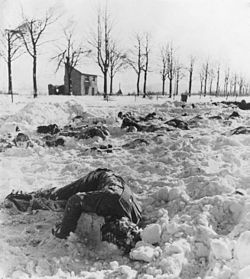Malmedy massacre
| Malmedy Massacre | |
|---|---|

Murdered American soldiers at Malmedy (picture taken on January 14, 1945).
|
|
| Location | near Malmedy, Belgium |
| Coordinates | 50°24′14″N 6°3′58.30″E / 50.40389°N 6.0661944°ECoordinates: 50°24′14″N 6°3′58.30″E / 50.40389°N 6.0661944°E |
| Date | December 17, 1944 |
|
Attack type
|
Mass murder |
| Deaths | 84 American POWs |
| Perpetrators | 1st SS Panzer Division |
The Malmedy massacre (1944) was a war crime in which 84 American prisoners of war were killed by their German captors near Malmedy, Belgium, during World War II. The massacre was committed on December 17, 1944, at Baugnez crossroads, by members of Kampfgruppe Peiper (part of the 1st SS Panzer Division), a German combat unit, during the Battle of the Bulge.
The term also applies generally to the series of massacres committed by the same unit on the same day and following days, which were the subject of the Malmedy massacre trial, part of the Dachau Trials of 1946. The trials were the focus of some controversy.
Hitler's plans for the Battle of the Bulge gave the main goal (breaking through Allied lines) to the 6th SS Panzer Army, commanded by General Sepp Dietrich. He was to break the Allied front between Monschau and Losheimergraben, cross the Meuse River, and then capture Antwerp.Kampfgruppe Peiper, named after and under the command of SS-Obersturmbannführer Joachim Peiper, was composed of armoured and motorized elements and was the spearhead of the left wing of the 6th SS Panzer Army. Once the infantry had breached the American lines, Peiper's role was to advance via Ligneuville, Stavelot, Trois-Ponts, and Werbomont and seize and secure the Meuse bridges around Huy. The best roads were reserved for the bulk of the 1st SS Panzer Division Leibstandarte SS Adolf Hitler. Peiper was to use secondary roads, but these proved unsuitable for heavy armoured vehicles, especially the Tiger II tanks attached to the Kampfgruppe. The success of the operation depended on the swift capture of the bridges over the Meuse. This required a rapid advance through US positions, circumventing any points of resistance whenever possible. Another factor Peiper had to consider was the shortage of fuel: the fuel resources of the Reich had been greatly reduced since the fall of Romania.
...
Wikipedia
